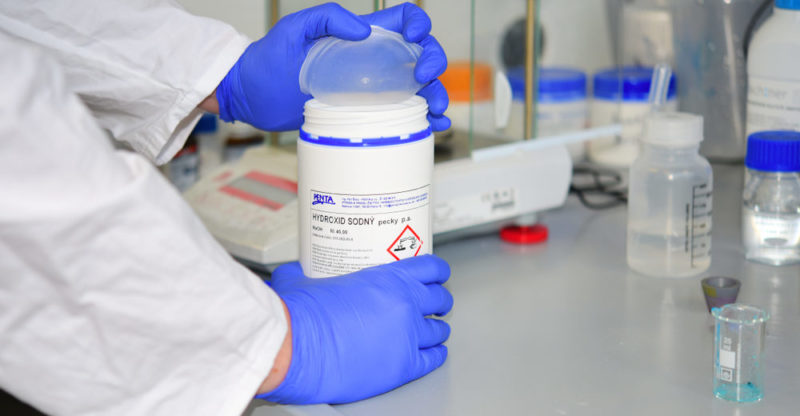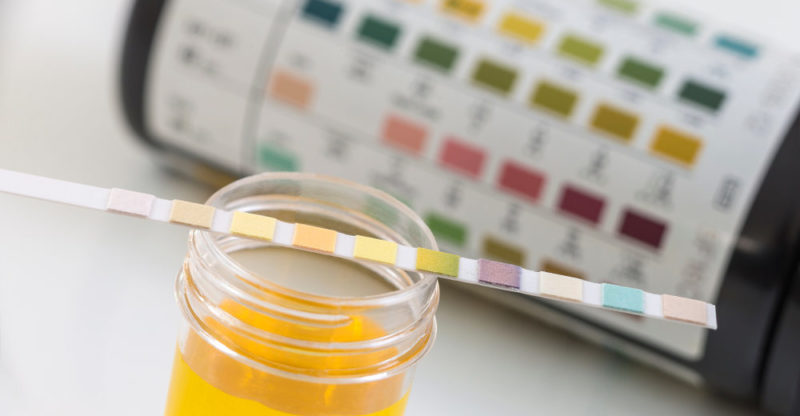We explain what acids and bases are and how these substances can be measured. Also, what are its characteristics and various uses.
What are acids and bases?
Acids and bases are substances that exist in nature and are distinguished by their pH level , that is, by their degree of acidity or alkalinity. Both, however, tend to be corrosive, often toxic substances, which nonetheless have numerous industrial and human applications.
Acids are substances with a pH lower than 7 (pH of the water equal to 7, considered neutral), whose chemistry commonly contains large amounts of hydrogen ions when water is added . They tend to react to other substances by losing protons (H + ).
Bases, on the other hand, are substances with a pH greater than 7 , which in aqueous solutions usually contribute hydroxyl ions (OH - ) to the medium. They are usually powerful oxidants, that is, they react with protons in the surrounding environment.
The reaction between acids and bases is called neutralization, and it more or less removes the acidic or basic properties of both compounds, producing water and a salt instead.
Characteristics of acids and bases

- Sabor . Bases and acids are easily distinguished by their taste. The former have a characteristic bitter taste, while the acids are usually sour, like the citric acid in lemon. Some less intense bases tend to show flavors similar to soap.
- Electrical conductivity . Both acids and bases, in aqueous solutions, are very good electrical conductors. That is due to its ability to generate electrically charged ions.
- Solubility . Acids and bases are soluble in water, generally speaking. However, many strong bases such as caustic soda (NaOH) release an enormous amount of energy when doing so (exothermic reaction) so that their contact with this liquid is considered a severe flammable risk.
- Reactivity . Acids and bases are distinguished in that acids give up protons while bases accept protons from their accompanying substances. This means that they tend to react chemically in different ways to substances such as organic matter, although in both cases the visible effect is corrosion: both acids and bases can cause severe burns to the skin , for example.
- Appearance . Acids have an oily consistency, while some bases can have a soapy touch. However, in solid state they tend to be more or less porous and brittle, depending on the specific substance. Some acidic or basic gases are even visible to the naked eye.

Neutralization
When mixing a base with an acid, a neutralization effect occurs , in which the protons released by the acid are accepted by the base, and both lose part (or all) of their acidic or basic properties.
As a product of this reaction, water and some type of salt are formed, depending on the acid and base involved. Therefore, the resulting substance is neither sour nor alkaline, but salty. For example: hydrochloric acid (HCl (aq) ) reacts with sodium hydroxide (NaOH) to form the salt of sodium chloride (NaCl) and water (H 2 O).
Physical states

Both acids and alkalis can be found in any of the three states of aggregation of matter: solid (powder), gaseous or liquid .
Gaseous forms are those with the highest industrial and human risk, since they often cannot be perceived before being inhaled and cause damage to the respiratory system .
PH measurement

To measure the pH (acidity or alkalinity of a substance in aqueous solution) of substances , acid-base indicators are used , which are substances, materials or measuring instruments that serve to measure the acidity or alkalinity of a chemical compound.
There is a special type of paper called blue litmus paper , which changes its color to red if it comes into contact with an acid and nothing happens to a base.
There are also liquid substances such as phenolphthalein that turn pink if it is in contact with a base , and colorless if it is in contact with an acid. On the other hand, methyl orange is a pH indicator that has a red color at pH less than 3 and yellow at pH greater than 4.
Applications of acids and bases

Both bases and acids have numerous industrial applications:
- Acids . Its corrosive properties are used to remove rust and other impurities from industrial substances (such as metals ). In addition, they are used in chemical reactions that allow obtaining electricity (as in the case of batteries). In addition, they form part of fertilizers and are often used as catalysts in controlled chemical reactions, to obtain specific products in the laboratory.
- Bases . They are often used as desiccants or products to combat humidity, as well as cleaning and disinfection substances, such as soap, chlorine in swimming pools, even ammonia. They are also produced as acid counteracting drugs, such as sodium bicarbonate, or purgatives such as milk of magnesia.
Nomenclature

The name of the acids comes from the Latin acidus , which means " sour " ; the bases, on the other hand, called alkalis, get their name from the Arabic Al-Qaly , which translates as “ash”. In these names it can be seen how man has dealt with them since ancient ages, trying to discern one from another based on their characteristics.
Nomenclature of acids.
Oxacids . They are acids that contain oxygen, a nonmetal, and hydrogen. To name them, prefixes and suffixes are used that depend on the amount of oxidation numbers that the nonmetal has. For example:
- If the nonmetal has four oxidation numbers:
- For the lowest oxidation number . The word 'acid' is written followed by the prefix 'hypo-' of the word that refers to nonmetal, followed by the suffix '-oso'. For example: hypochlorous acid (HClO), chlorine has oxidation number 1+.
- For the following oxidation number . The word 'acid' is written followed by the word that refers to the nonmetal, followed by the suffix '-oso'. For example: chlorous acid (HClO 2 ), chlorine has oxidation number 3+.
- For the oxidation number that follows . The word 'acid' is written followed by the word that refers to the nonmetal, followed by the suffix '-ico'. For example: chloric acid (HClO 3 ), chlorine has oxidation number 5+.
- For the highest oxidation number . The word 'acid' is written followed by the prefix 'per-' of the word that refers to the nonmetal, followed by the suffix '-ico'. For example: perchloric acid (HClO 4 ), chlorine has oxidation number 7+.
- If the nonmetal has two oxidation states:
- For the lowest oxidation number . The word 'acid' is written followed by the word that refers to the nonmetal, followed by the suffix '-oso'. For example: sulfurous acid (H 2 SO 3 ), sulfur has oxidation number 4+.
- For the highest oxidation number . The word 'acid' is written followed by the word that refers to the nonmetal, followed by the suffix '-ico'. For example: sulfuric acid (H 2 SO 4 ), sulfur has oxidation number 6+.
Nomenclature of the bases
Most of the bases are usually called hydroxides , alluding to the hydroxyl functional group (OH -) that these compounds present. They are named by writing the phrase 'hydroxide of' followed by the name of the metal, followed by the oxidation number of the metal in Roman numerals and in parentheses (in case it has more than one oxidation number). For example: sodium hydroxide (NaOH), magnesium hydroxide (Mg (OH) 2 ), iron (II) hydroxide (Fe (OH) 2 ) and iron (III) hydroxide (Fe (OH) 3 ).
The above content published at Collaborative Research Group is for informational and educational purposes only and has been developed by referring reliable sources and recommendations from experts. We do not have any contact with official entities nor do we intend to replace the information that they emit.
MA student of the TransAtlantic Masters program at UNC-Chapel Hill. Political Science with a focus on European Studies. Expressed ideas are open to revision. He not only covers Technical articles but also has skills in the fields of SEO, graphics, web development and coding. .
Leave a reply
Your email address will not be published. Required fields are marked *Recent post

Sport: What Is It, Types, Risks, Features, Characteristics and Examples

Dogs: Emergence, Features, Characteristics, Feeding and Breeds

Story: Definition, Elements, Structure, Features and Characteristics

